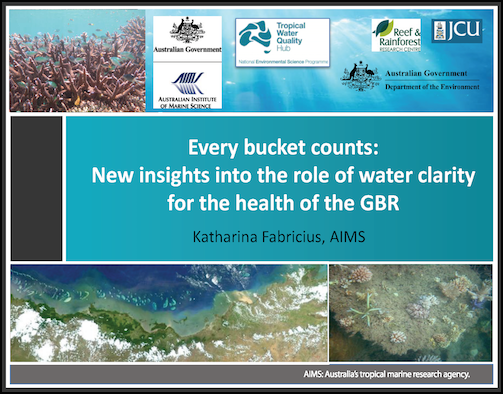Benthic light as ecologically-validated GBR-wide indicator for water quality: drivers, thresholds and cumulative risks
Led by: Dr Katharina Fabricius, AIMS
Project Summary
The project will develop a water quality indicator based on benthic irradiance (the amount of light penetrating to the seafloor). Using experiments and field data we will develop irradiance thresholds for measures of ecosystem health, and develop prototype guideline values. The project will develop a new remote sensing algorithm of benthic irradiance, validated against open-water irradiance data. The project will quantify benthic irradiance throughout the GBR, near-daily over 14 years, and assess region-specific drivers of trends including river discharges. The indicator can directly feed into Reef Plan report cards, irradiance as a limiting factor, and about cumulative risks in the context of coral bleaching.
Project Publications
Science Day, 20th November, Townsville
Problem Statements
Problem
The availability of sufficient light (irradiance) is essential for photosynthesis, the foundation of all food webs and the dominant source of energy for corals and seagrasses. The most important part of the light spectrum for marine organisms is photosynthetically active radiation, or PAR, and the amount of light reaching the sea floor is ‘benthic PAR’.
PAR is critical for corals and other photosynthetic benthic organisms, and light reduction is known to reduce ecosystem health. On the other hand, the cumulative stress of high light and high temperatures can lead to coral bleaching. Benthic PAR degrades in response to terrestrial run-off and subsequent resuspension of fine sediments, nutrients and organic matter, due to cyclone-induced vertical mixing, and due to dredging. However, ecologically relevant, regionally specific light thresholds for corals and ecosystem health have not been determined. Further, a responsive, ecologically relevant water quality indicator that describes the light environment at local and GBR-wide scales is currently unavailable.
How Research Addresses Problem
This truly integrated project will:
1. Define ecologically relevant thresholds in irradiance that can be used for management: Experimental work and field data (Seabed biodiversity, MMP) will be used to quantify the influence of PAR on coral health, and on some of the ecological health indicators used by MMP for report cards (e.g coral juveniles, growth and survival, macroalgal abundance, etc);
2. Develop a benthic irradiance product (bPAR) derived from satellite data
3. Synthesize the work into an easily measured, responsive and ecologically relevant water quality indicator (WQI) that is directly linked to human activities (run-off, dredging, onground
management actions).
Why choose irradiance as a water quality indicator?
- Using directly measured bPAR as a WQI will give more universal information on WQ problems, drivers, mitigation effectiveness and trends throughout the last 14 years, than using the responses of specific organism groups (which vary in their sensitivities between species, life stages, origins etc).
- Our WQI will inform on resuspension related conditions throughout the year as well as during floods and cyclones. This is essential, since we have shown through NERP that GBR water clarity can remain low for >6 months after floods, not only inshore but in some regions even on the mid- and outershelf (Fabricius et al., 2014, Logan et al. 2015).
- bPAR will be measured from satellites and hence will be freely-available for the whole GBR at 1 km2 spatial resolution including the Far North. It can be hind-casted for at least 14 years, and its drivers such as river runoff determined. Its values together with uncertainties can be directly incorporated into Reef Plan reporting and eReefs,
- bPAR could become an additional measure for the GBRMPA Water Quality Guidelines, providing complementary information to Secchi depth and chlorophyll.
Alignment with NESP Research Priorities
2a) Developing effective and cost-effective catchment and marine water quality indicators, thresholds and sub-lethal health-indicators for key marine organisms and processes in support of the Reef.
Project Keywords
Benthic irradiance; Thresholds; Water quality indicator; Water quality guideline; Ecosystem health.
Project Funding
This project is jointly funded through AIMS, UQ, JCU and the Australian Government’s National Environmental Science Programme.
Project Map
Markers are not an exact position of where the research is taking place, they are only to be used as a guide to the general area in which it is being carried out.







